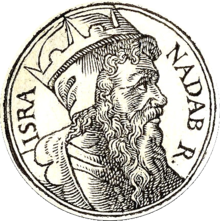| Nadab | |
|---|---|
 Nadab from Guillaume Rouillé's Promptuarii Iconum Insigniorum | |
| King of Northern Israel | |
| Reign | 910–909 BCE |
| Predecessor | Jeroboam |
| Successor | Baasha |
| Father | Jeroboam |
Nadab (Hebrew: נָדָב Nāḏāḇ) was, according to the Hebrew Bible, the second king of the northern Israelite Kingdom of Israel. He was the son and successor of Jeroboam.
Reign[edit]
Nadab became king of Israel in the second year of Asa, King of Judah, and reigned for two years.[1][2] William F. Albright has dated his reign to 901–900 BCE, while E. R. Thiele offers the dates 910–909 BCE.[3]
In the second year of his reign, while they were besieging Gibbethon, a Philistine town in southern Dan, a conspiracy broke out in Nadab's army. He was slain by one of his own captains, Baasha, who then made himself king of Israel.[2]
Having slain Nadab, Baasha put to death the remainder of the royal family (1 Kings 14:20, 15:25–29). This was consistent with the prophecy given via Ahijah the Shilonite concerning the extinction of the entire House of Jeroboam.[2]
References[edit]
- ^ 1 Kings 15:25
- ^ a b c "Nadav", Jewish Encyclopedia
- ^ Edwin Thiele, The Mysterious Numbers of the Hebrew Kings, (1st ed.; New York: Macmillan, 1951; 2d ed.; Grand Rapids: Eerdmans, 1965; 3rd ed.; Grand Rapids: Zondervan/Kregel, 1983). ISBN 0-8254-3825-X, 9780825438257
![]() This article incorporates text from a publication now in the public domain: Easton, Matthew George (1897). "Nadab". Easton's Bible Dictionary (New and revised ed.). T. Nelson and Sons.
This article incorporates text from a publication now in the public domain: Easton, Matthew George (1897). "Nadab". Easton's Bible Dictionary (New and revised ed.). T. Nelson and Sons.
Well, that’s interesting to know that Psilotum nudum are known as whisk ferns. Psilotum nudum is the commoner species of the two. While the P. flaccidum is a rare species and is found in the tropical islands. Both the species are usually epiphytic in habit and grow upon tree ferns. These species may also be terrestrial and grow in humus or in the crevices of the rocks.
View the detailed Guide of Psilotum nudum: Detailed Study Of Psilotum Nudum (Whisk Fern), Classification, Anatomy, Reproduction